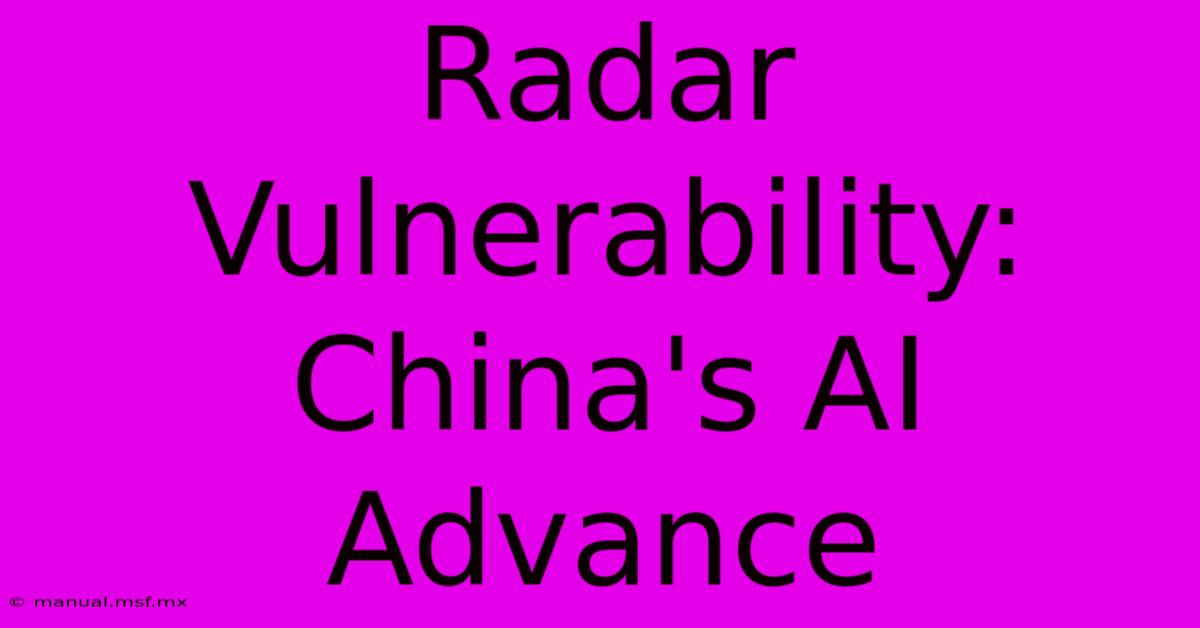Radar Vulnerability: China's AI Advance

Discover more detailed and exciting information on our website. Click the link below to start your adventure: Visit Best Website. Don't miss out!
Table of Contents
Radar Vulnerability: China's AI Advance - Unmasking the Silent Threat
Is China's AI advancement creating a silent threat to global radar systems? Radar vulnerability is a growing concern as AI's rapid evolution intersects with military technology. Editor Note: This article explores the potential vulnerabilities created by China's AI advancements in the domain of radar technology. Understanding these vulnerabilities is critical for maintaining national security and ensuring a stable international landscape.
Why is this topic so important? As the world relies on radar for air defense, navigation, and weather forecasting, its reliability is paramount. AI's potential to disrupt these systems presents a real challenge, especially in light of China's rapid advancements in this field.
Our analysis delves into the key areas where AI could compromise radar systems, examining how Chinese research and development are influencing this field. We've reviewed academic papers, government reports, and industry news to provide a comprehensive overview of the challenges and opportunities associated with radar vulnerability.
Key takeaways:
| Vulnerability | Description |
|---|---|
| AI-powered jamming | Using AI to create sophisticated jamming signals that can overwhelm radar systems |
| AI-driven spoofing | Generating false targets or manipulating radar data to confuse detection systems |
| Adaptive camouflage | Employing AI to design materials that absorb radar signals, making targets invisible |
| AI-enhanced detection | Leveraging AI to improve the ability of radar systems to detect stealth aircraft |
Radar Vulnerability
AI-powered jamming
AI can generate complex, dynamic jamming signals that are difficult for traditional radar systems to filter out. This could effectively blind radar systems, leaving them unable to detect aircraft, missiles, or other objects. China's investment in AI-powered electronic warfare systems suggests their interest in exploiting this vulnerability.
AI-driven spoofing
Sophisticated AI algorithms can create realistic "phantom" targets that mimic the radar signatures of real aircraft, confusing radar operators and potentially diverting defenses. The development of AI-driven spoofing techniques could make it difficult for militaries to distinguish between genuine threats and false alarms.
Adaptive camouflage
China's research in metamaterials and advanced composite materials could lead to the development of AI-controlled camouflage systems that adapt to different radar frequencies. This could render aircraft, ships, or other military assets invisible to radar detection.
AI-enhanced detection
China's advancements in AI-powered signal processing could lead to the development of more sophisticated radar systems capable of detecting stealth aircraft and other low-observable targets. This would pose a challenge for countries relying on stealth technology for strategic advantage.
Conclusion
The potential for AI to disrupt radar systems presents a significant challenge for global security. China's advancements in AI technology, particularly in the areas of electronic warfare and materials science, underscore the need for vigilance. By understanding the vulnerabilities and developing appropriate countermeasures, countries can mitigate the risks and ensure the continued reliability of radar systems.
FAQ
Q: How can AI improve radar systems? A: AI can be used to enhance radar data analysis, improve target identification, and optimize radar system performance. It can also be used to develop more efficient and effective radar jamming techniques.
Q: Are there any countermeasures to AI-powered radar threats?
A: Countermeasures include developing AI-powered radar defense systems, improving radar signal processing techniques, and investing in advanced camouflage technologies.
Q: What is the future of radar vulnerability?
A: The development of AI-based radar systems and countermeasures will continue to evolve, creating a complex and dynamic landscape. Countries will need to invest in research and development to stay ahead of the curve and ensure the security of their critical infrastructure.
Tips for mitigating radar vulnerability
- Invest in AI-powered radar defense systems: Develop advanced systems that can identify and counter AI-powered jamming and spoofing techniques.
- Enhance signal processing: Improve radar signal processing algorithms to better discriminate between real and false targets.
- Develop advanced camouflage: Invest in technologies that can effectively shield targets from radar detection.
- Engage in international collaboration: Work with allies to share information and develop joint solutions to mitigate radar vulnerabilities.
Summary
The growing intersection of AI and radar technology creates a new era of potential vulnerabilities. China's rapid advancements in this field underscore the importance of understanding and mitigating these risks. By investing in research, developing countermeasures, and fostering international collaboration, countries can safeguard the vital role of radar systems in modern security and defense.

Thank you for visiting our website wich cover about Radar Vulnerability: China's AI Advance . We hope the information provided has been useful to you. Feel free to contact us if you have any questions or need further assistance. See you next time and dont miss to bookmark.
Also read the following articles
| Article Title | Date |
|---|---|
| Shl Startar Om Modo Saknas | Nov 15, 2024 |
| Finney Smith Injury Keeps Him Out Wednesday | Nov 15, 2024 |
| The Onion Acquires Infowars Jones Outraged | Nov 15, 2024 |
| Tyson Vs Paul Le Combat Confirme | Nov 15, 2024 |
| Tech Tonic Ai Supremacy And Metas Llama | Nov 15, 2024 |
| Preview Indonesia Vs Japan Lineups And Prediction | Nov 15, 2024 |
| Cop 16 Fortschritte Fuer Biodiversitaet | Nov 15, 2024 |
| France 0 0 Israel Les Bleus Advance | Nov 15, 2024 |
| England Vs Greece Team News And Starting Lineups | Nov 15, 2024 |
| Asker Eglencesinde Silahli Saldiri | Nov 15, 2024 |
